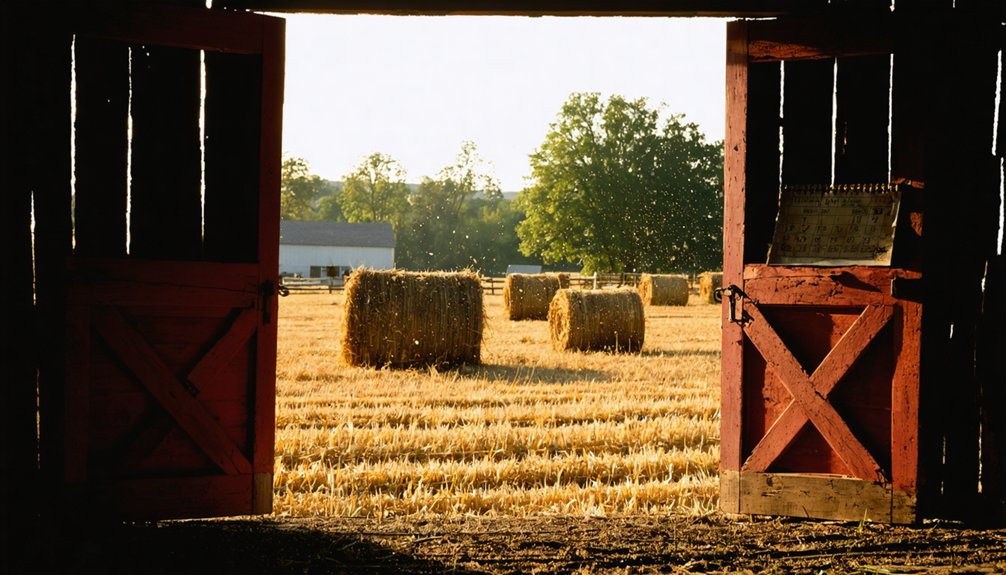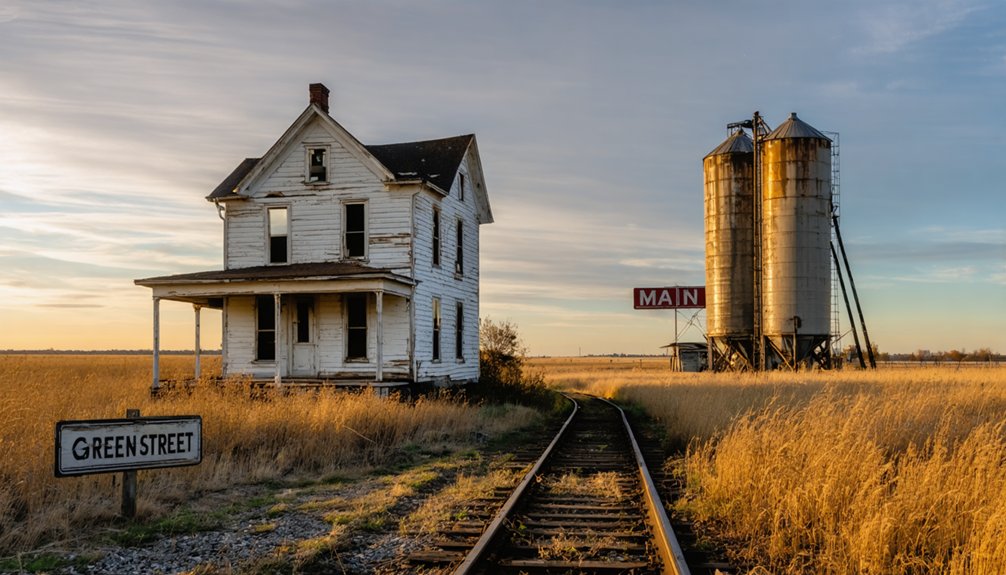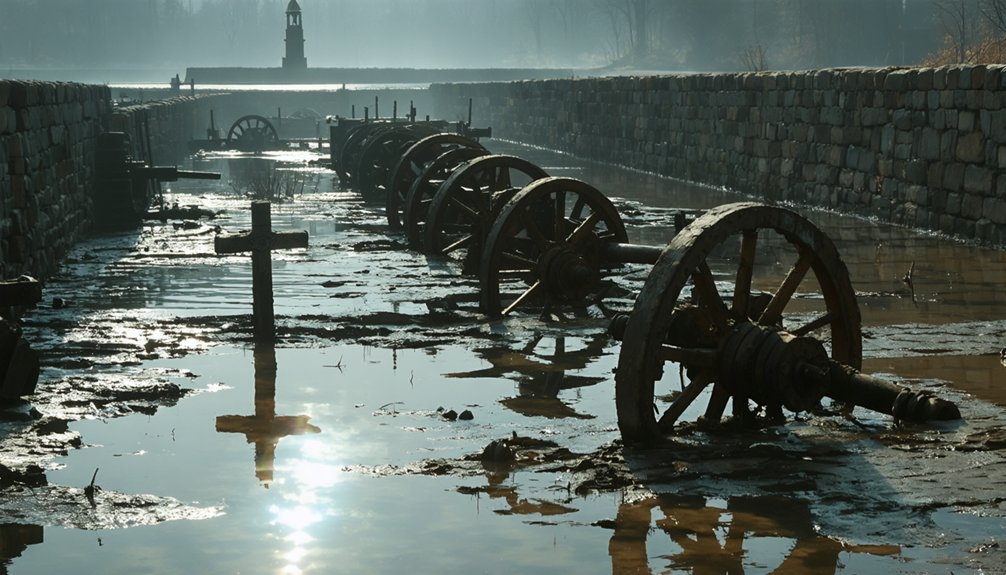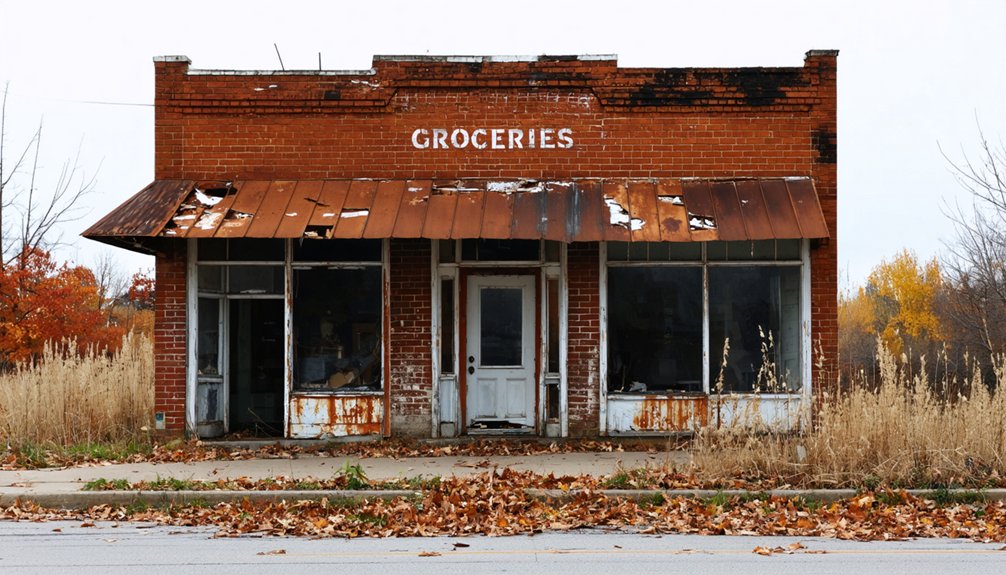You’ll find Green Island’s haunting story along Iowa’s Mississippi River, where a once-bustling railroad town met its fate in 1965. Founded in 1839 by James Clark, the community thrived through its strategic location, railroad yards, and essential stockyards that helped it weather the Great Depression. After devastating floods forced evacuation, the town’s remnants now rest beneath the waters, transformed into a 4,000-acre wildlife management area that holds countless untold stories.
Key Takeaways
- Founded in 1839 by James Clark, Green Island was a thriving railroad and agricultural community in Iowa’s early history.
- The town’s economy centered on railroad operations and a stockyard, providing stability through the Great Depression.
- Population declined significantly after World War II due to decreased railroad employment and youth exodus.
- A devastating flood in 1965 led to the town’s abandonment when residents evacuated and never returned.
- The former town site is now a 4,000-acre wildlife management area offering recreation and conservation opportunities.
The Birth of Clarkstown and Its Evolution
While James Clark’s arrival in 1839 established the initial settlement of Clarkstown, the community’s identity would soon transform with the advent of the railroad.
The area’s roots stretch back to colonial times when it was part of the Manor Rensselaerwycke, with early settlers like Col. Kiliaen Van Rensselaer and Col. Pieter Schuyler shaping its foundation.
You’ll find the town’s evolution reflected in its changing names – from The Turkee Farm to Tibbits Island, and finally to Green Island. To avoid confusion with other locations, the town required clear disambiguation efforts.
This transformation wasn’t just nominal; it represented the shifting identity of a community embracing new opportunities.
The community showed remarkable resilience during the 1930s as the active stockyard and railroad provided economic stability while other areas struggled through the Great Depression.
Railroad’s Golden Era and Town Growth
If you’d visited Green Island during the railroad’s heyday, you’d have found a bustling hub where the Chicago, Rock Island and Pacific Railroad connected the town to major markets across Iowa and beyond.
The railroad’s presence transformed the former Clarkstown into a significant transportation center, with its stockyards and rail yards providing steady employment for local residents. The town’s commitment to security and development matched that of modern systems, employing verification processes to protect its assets. Like the historic Mississippi & Missouri railroad that first brought passenger service to Iowa in 1856, Green Island’s rail line was vital to the region’s growth.
Even during the Great Depression of the 1930s, Green Island’s railroad-based economy helped shield its residents from the worst economic hardships that plagued other communities.
Railroad Hub Development
During the railroad’s golden era of the late 1800s, Green Island transformed from a small Mississippi River settlement into a bustling transportation hub.
You’d have witnessed an incredible railroad expansion as Iowa’s rail network grew from 2,683 miles in 1870 to nearly 9,200 by 1900, with Green Island positioned perfectly to capitalize on both river and rail commerce.
The town’s economic transformation was dramatic.
You would’ve seen new hotels springing up alongside repair shops and warehouses, all catering to the surge in rail traffic.
The railroad yards created essential local jobs while connecting Green Island to major markets in Chicago and Omaha.
If you’d invested in local land during this period, you’d have likely seen your property values soar as the town’s strategic location attracted businesses and settlers enthusiastic to tap into the expanding rail network.
Stockyards Boost Commerce
The arrival of a bustling stockyard in Green Island marked a transformative era for the town’s commerce in the 1930s. You’d find the stockyard humming with activity as it served as an essential hub for livestock trade, connecting local farmers to broader markets beyond Iowa’s borders.
While other communities struggled through the Great Depression, Green Island’s strategic combination of stockyard and rail facilities helped shield the town from the worst economic impacts. Similar to the commission firms that operated in Sioux City, agents facilitated sales between producers and buyers. The cash scarcity during this period often led farmers to trade their livestock directly for needed goods.
The stockyard’s success rested on its seamless integration with the railroad, allowing you to witness efficient loading and unloading of cattle and hogs bound for distant markets.
This powerful partnership created stable jobs and boosted local commerce, positioning Green Island as a key player in the region’s agricultural economy during the railroad’s golden age.
Life Along the Mississippi River
Life along the Mississippi River shaped every aspect of Green Island’s existence, from daily routines to long-term survival. You’d find residents constantly adapting to the river’s unpredictable nature, planning their farming, fishing, and travel around its changing moods.
The river ecosystems provided both opportunities and challenges – offering rich soil for agriculture and abundant fish, while threatening livelihoods with frequent floods. The area encompassed 4,000 acres of diverse wetlands that local residents learned to navigate and utilize.
Community resilience showed in how families adjusted to river conditions, whether ice skating in winter or steering through summer’s high waters.
You’d see children walking to Bryant School regardless of weather, while their parents worked the railroad yards or tended farms.
The river’s presence meant you couldn’t take anything for granted – from daily transport to seasonal harvests, everything depended on nature’s whims.
Agricultural Heritage and Stockyards
While neighboring river towns relied solely on waterways, Green Island’s agricultural prowess emerged from its innovative drainage systems and mechanized farming advances.
Green Island transcended river dependency through groundbreaking drainage technology and farm mechanization, setting it apart from neighboring settlements.
You’d have seen farmers investing heavily in cooperative drainage networks, installing main tiles and lateral systems that transformed wetlands into productive fields. Following the 1904 drainage districts law, local farmers could now petition for organized drainage plans with shared costs among landowners.
The town’s success rode on more than just water management. Agricultural innovations like early tractors boosted productivity, while livestock markets connected local farmers to broader economic opportunities. Like many Iowa farms, the area saw a dramatic 72 percent increase in the value of its agricultural products between 1899 and 1919.
You could’ve witnessed land values doubling as mechanization cut labor costs and improved profits. During the golden “farm parity” years of 1909-1914, Green Island’s farmers reaped returns comparable to industrial workers.
The stockyards became crucial hubs, integrating with rail lines to move cattle and hogs beyond the Mississippi’s shores.
Daily Life in a Small Iowa Community

If you’d lived in Green Island during its heyday, your daily schedule would’ve revolved around the railroad’s timetables, with many residents working shifts at the rail yard or in related service jobs.
When the railroad changed routes, the town experienced economic decline, reflecting a common pattern seen in many former railroad communities.
You’d have found the local church serving as more than just a place of worship – it was an essential social hub where families gathered for potlucks, meetings, and community celebrations.
After work hours and on weekends, you’d have joined your neighbors for school events, seasonal festivals, and impromptu gatherings at the general store, where railroad news and local gossip flowed freely.
Railroad Work Days
During the heyday of Green Island’s railroad era through World War II, you’d find the rhythms of daily life deeply intertwined with the constant motion of train operations.
You’d work shifts around the clock, maintaining railroad safety as freight trains hauled coal, grain, and livestock through the bustling yards. Whether you’re repairing steel tracks or coordinating freight logistics at the depot, every task kept the lifeblood of commerce flowing.
You’d brave the elements year-round, signaling trains and managing stockyard operations as multiple daily routes connected Green Island to the wider world.
Inside the depot, you’d coordinate with other rail lines, ensuring smooth changes between Rock Island and Burlington Northern services. The work wasn’t just a job – it was the economic engine that kept your community thriving.
Church and Social Life
As the heart of Green Island’s social fabric, you’d find the local church anchoring community life through weekly services and seasonal celebrations. You’d gather with neighbors inside the simple, solemn structure not just for worship, but for community meetings, social gatherings, and support during hard times.
Beyond the church community, you’d spend your days visiting the general store, sharing news at the post office, or participating in town festivals that brought everyone together.
Your children would attend the small local school, while you’d tend to your farm or trade with local craftsmen. During market days, you’d meet other families to sell produce and handmade goods.
Life centered around strong family bonds, seasonal rhythms, and the mutual support that defined small-town Iowa living.
The Great Depression Years
While the 1929 stock market crash marked the official start of the Great Depression nationwide, Green Island and its surrounding farming communities had already endured nearly a decade of economic hardship.
You’d have witnessed the devastating economic struggles as crop prices plummeted and farm foreclosures skyrocketed. The region’s farming families faced unprecedented challenges:
- Corn prices crashed to 8-10 cents per bushel, forcing some farmers to burn their crops for fuel.
- Pork dropped to three cents a pound, while eggs sold for just ten cents per dozen.
- Bank closures left the community without access to essential financial resources.
- Farm debt from wartime expansion exceeded income by 50% by 1932.
Local farmers fought back through protests and organizations like the Farmers Holiday Association, though these efforts brought limited relief until federal programs arrived in 1933.
Post-War Changes and Decline

After World War II ended in 1945, Green Island faced a devastating economic transformation that would ultimately seal its fate.
You’d have witnessed the rapid decline of railroad employment, which had been the town’s economic backbone. Without economic resilience, local businesses struggled as workers and their families left in search of better opportunities elsewhere.
The town’s challenges intensified when a destructive flood struck in 1965, damaging homes and infrastructure.
Community revitalization efforts proved difficult as Green Island lacked diverse industries to replace the dwindling railroad jobs. The aging population and exodus of younger residents further weakened the social fabric.
The once-bustling stockyards couldn’t compensate for the broader economic downturn, and the isolated location made attracting new businesses nearly impossible.
The town’s dependency on external factors had become its greatest vulnerability.
The Final Days of Green Island
Before the devastating flood of 1965, Green Island clung to existence with just 97 residents, their lives intertwined in a close-knit but diminishing community.
Despite their environmental vulnerability, these remaining townsfolk demonstrated remarkable community resilience, maintaining social bonds in their isolated riverside home.
You’ll find these critical elements shaped Green Island’s final chapter:
- The town’s physical footprint had already shrunk considerably, mirroring its declining population.
- Daily life centered around the few remaining active businesses and social gatherings.
- Strong social ties kept the community connected despite economic challenges.
- Railroad employment had dwindled, weakening the town’s economic foundation.
When the flood waters rose in 1965, they claimed every structure, forcing an abrupt evacuation.
No rebuilding attempts followed, and Green Island slipped beneath the Mississippi’s waters forever.
Beneath the Waters: A Submerged Legacy

Once the Mississippi River claimed Green Island in 1965, the town joined a legacy of submerged communities across Iowa, though its story stands apart from planned reservoir towns.
Unlike the six communities deliberately flooded to create Lake Red Rock, Green Island’s submersion wasn’t part of a calculated flood control project.
Today, you’ll find Green Island’s submerged history preserved differently than its reservoir counterparts. While Lake Red Rock’s towns like Coalport and Red Rock were methodically cleared for the dam project, Green Island’s transformation was more sudden.
The area now serves as a reflection of nature’s power to reshape communities, contributing to a delicate ecological balance. Where 97 residents once lived their daily lives, the land now supports a thriving wildlife management area, marking a profound shift in the landscape’s purpose.
Green Island Wildlife Management Area Today
You’ll find the 4,000-acre Green Island Wildlife Management Area bustling with conservation efforts focused on restoring natural water cycles and enhancing habitat for native species.
The area’s extensive wetland complex offers you excellent opportunities for birding, hiking, and hunting, though access can be limited by seasonal flooding of the Mississippi River.
The Iowa DNR’s flood management strategies have become increasingly critical as they work to protect both wildlife habitats and public recreational facilities from the river’s rising waters.
Wildlife Conservation Activities
As a premier wetland complex in Iowa, the Green Island Wildlife Management Area spans over 4,000 acres of diverse habitats where conservation efforts focus on restoring natural river processes and maintaining native ecosystems.
Through dedicated wildlife monitoring and habitat restoration, you’ll find a rich mosaic of wetlands, uplands, and timber distributed across this dynamic landscape.
Key conservation activities you can explore include:
- Ongoing restoration of historic water cycles and sediment management
- Enhancement of aquatic habitats through vegetation management and water quality improvements
- Protection of diverse wildlife populations, from Yellow-crowned Night-Herons to various mammals
- Maintenance of public access areas while regulating activities to guarantee habitat sustainability
The area’s management involves multiple agencies working together to protect this unique ecosystem while providing recreational opportunities for outdoor enthusiasts.
Public Recreation Options
While conservation efforts maintain the ecological integrity of Green Island Wildlife Management Area, the landscape offers extensive recreational opportunities across its 3,700 acres.
You’ll find miles of levee trails perfect for wildlife observation, where you can spot diverse bird species without retracing your steps. For water enthusiasts, there’s 24/7 access to Green Island Lake and Mississippi River backwaters for fishing, kayaking, and canoeing via multiple boat ramps.
The area’s primitive nature means you’re free to explore without the constraints of developed facilities. You can drive gravel roads for casual birding, hike through natural vegetation, or hunt during designated seasons.
Just remember, you’ll need to be self-sufficient – there aren’t any modern amenities, and you’ll want to pack out what you bring in.
Flood Management Impact
Despite its strategic location along the Mississippi River, Green Island Wildlife Management Area faces significant challenges from recurring floods that have damaged critical infrastructure throughout the 4,000-acre wetland complex.
You’ll see innovative flood resilience strategies and habitat restoration efforts underway to protect this unique ecosystem while maintaining public access.
Key flood management initiatives include:
- Replacing traditional riprap with articulating block mats on levees to combat erosion
- Upgrading culverts from 36 to 48 inches to improve drainage capacity
- Installing sediment control structures to preserve aquatic habitats
- Implementing the Habitat Rehabilitation and Enhancement Project to restore natural river processes
These improvements help balance flood protection with wildlife conservation, ensuring you can continue exploring this remarkable floodplain environment despite its vulnerable location.
Frequently Asked Questions
Were Any Artifacts Recovered From Green Island Before the Flooding?
You won’t find any verified artifact recovery efforts before the waters rose. While the site’s significance remains intriguing, there’s no documented evidence of systematic collection methods from the town’s final days.
What Happened to the Town’s Cemetery During the Flooding?
You’ll find the cemetery suffered severe flooding aftermath, with waters submerging graves, damaging monuments, and risking displacement of remains. Rising waters and debris caused significant cemetery impact, complicating preservation efforts.
Did Any Former Residents Organize Reunions After the Town’s Abandonment?
You won’t find documented evidence of reunion planning among former residents, though they likely shared memories informally. Historical records don’t mention any organized gatherings after the town’s abandonment in 1965.
What Was the Average Property Value in Green Island Before Abandonment?
You won’t find exact property market values from Green Island’s pre-abandonment era – the historical records are too sparse. Based on the area’s historical significance, values likely matched other small, rural Iowa towns.
Were There Any Attempts by Residents to Prevent the Flooding?
With 97 residents facing displacement, you won’t find records of significant flood prevention efforts by Green Island’s community. The town’s fate was sealed by federal dam projects rather than local resistance.
References
- https://kids.kiddle.co/List_of_ghost_towns_in_Iowa
- https://www.timesrepublican.com/news/todays-news/2023/08/historian-brings-marshall-countys-ghost-towns-to-life/
- https://mississippivalleytraveler.com/green-island/
- https://pubs.lib.uiowa.edu/annals-of-iowa/article/id/6960/download/pdf/
- https://pubs.lib.uiowa.edu/annals-of-iowa/article/id/6984/download/pdf/
- https://www.hauntedplaces.org/green-island-ia/
- http://villageofgreenisland.com/wp-content/uploads/2011/04/History-of-Green-Island-2.pdf
- https://en.wikipedia.org/wiki/List_of_ghost_towns_in_Iowa
- http://sites.rootsweb.com/~nytigs/GreenIslandTimeLine.pdf
- https://en.wikipedia.org/wiki/Green_Island



